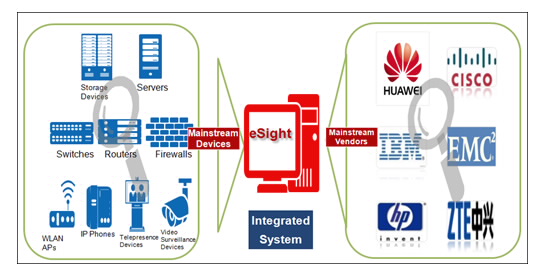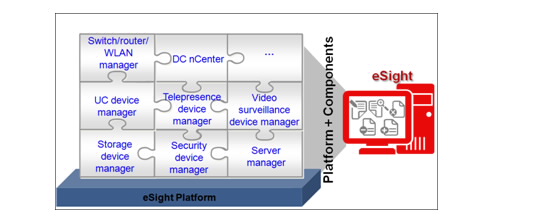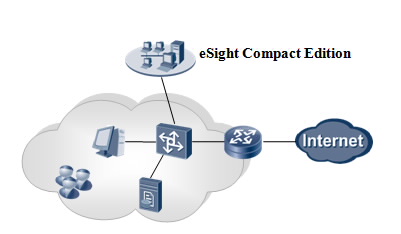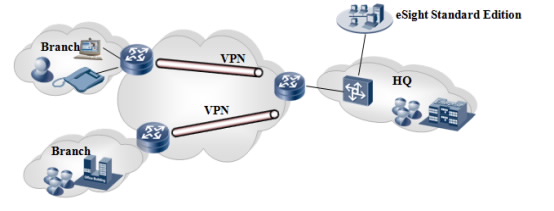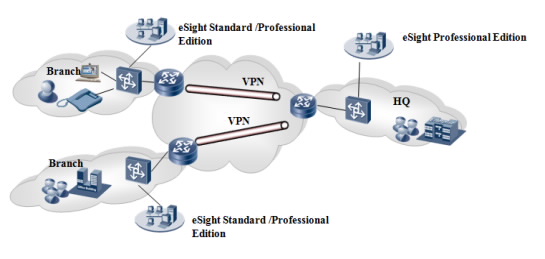| Component
|
Description
|
| eSight Platform
|
Provides various editions (compact, standard, and professional) for enterprises. In addition to unified management of devices from various vendors, topology management, fault management, performance management, smart configuration tool, and configuration file management, eSight Platform allows users to manage third-party devices in a customized manner, helping users to establish a network management system catering for their own needs.
|
| eSight Network Device Manager
|
Manages network devices.
|
| eSight Unified Communications/Contact Center (UC/CC) Device Manager
|
Manages UC/CC devices.
|
| eSight Video Surveillance Device Manager
|
Manages video surveillance devices.
|
| eSight Telepresence Device Manager
|
Manages telepresence devices.
|
| eSight Storage Device Manager
|
Manages Huawei low-end, mid-range, and high-end storage devices.
|
| eSight Server Manager
|
Manages server devices (rack and blade servers).
|
| eSight Smart Reporter
|
Pre-integrates rich report templates to meet diverse operation and maintenance scenarios; and offers professional report design tools to customize statistics reports.
|
| eSight Service-Level Agreement (SLA) Manager
|
eSight SLA Manager, by working with the NQA function, provides 24/7 active diagnosis, measures the performance of links between network devices, and displays service quality in a quantitative manner. Administrators can set service quality thresholds on the SLA Manager. When a service deteriorates to a degree that is beyond the threshold, the SLA Manager remotely notifies administrators of the situation. Administrators can use the quick diagnosis function to diagnose link performance in real time and further locate the fault, which improves the operation and maintenance efficiency.
|
| eSight WLAN Manager
|
Manages wired and wireless networks, which helps users to deploy and adjust services in batches, rectify faults, and perform routine O&M.
|
| eSight Network Traffic Analyzer (NTA)
|
Provides in-depth network traffic analysis based on NetFlow, NetStream, and sFlow protocols. It collects traffic information sent by routers and Layer 3 switches and provides customized reports, helping network administrators learn about traffic and bandwidth usage and discover network bottlenecks in a timely manner. The traffic analysis information also provides basis for network planning and fault diagnosis.
|
| eSight MPLS VPN Manager
|
Integrates VPN information throughout the network into a visual managed object and graphically displays it in the topology. Therefore, administrators can easily monitor VPN services and diagnose faults, helping ensure the quality of key services.
|
| eSight MPLS Tunnel Manager
|
Automatically discovers the MPLS TE tunnels (RSVP-TE signaling-based dynamic tunnels and CR-Static signaling-based static tunnels) and LDP tunnels that have been deployed on the network, monitors the tunnels in real time, displays the tunnel running status dynamically, and monitors active-standby switchovers and bypasses, which visualizes network routers.
|
| eSight DC nCenter
|
Monitors network resources (including physical servers, VMs, vSwitches, and TOR switches), displays the topology of virtual resources and physical devices, and dynamically adjusts physical network policies based on VM changes.
|
| eSight Terminal Manager
|
Complies with the TP069 protocol and supports automatic and batch NE access, configuration delivery, and version upgrade, which greatly improves the O&M efficiency.
|
| eSight Storage Reporter
|
Provides reports of storage devices.
|
| eSight IPSec VPN Manager
|
Provides service monitoring and topology display capabilities.
|
| eSight Secure Center
|
Allows network administrators to configure security policies and manage firewall users.
|

